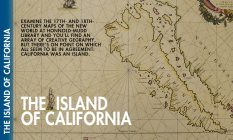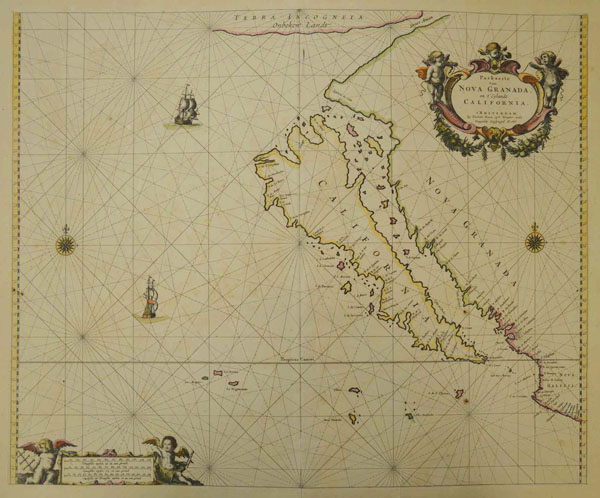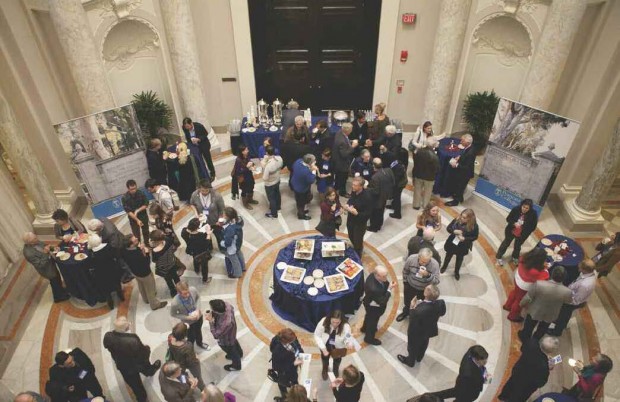
Sagehens Flock to Fall Networking Events
Last fall, as students convened on campus for another year of discovery, collaboration and fun, hundreds of alumni and friends also came together to learn and laugh in a series of networking events hosted by Pomona.
In November, more than 120 Sagehens braved the rain in Washington, D.C., to attend the College’s third annual “Pomona in the City.” Held at the stunning Carnegie Institution for Science, the event was hosted by Susanne Garvey ’74. Alumni, parents and friends mingled and enjoyed lectures from Pomona faculty Pierre Englebert, David Menefee-Libey, Cameron Munter, Mary Paster, John Seery and Lenny Seligman, and from President David Oxtoby.
Sagehens on the right coast also flocked to the College’s first East Coast Career Networking Series, with events in New York City, Boston and Washington, D.C. The NYC event, hosted by John Popp ’78, was headlined by The New York Times education reporter Richard Pérez-Peña ’84. In Boston, award-winning architect Chris Chu ’76 shared highlights of her career journey (including a feature on HGTV’s “This Old House Boston”), and the series concluded in the Beltway with remarks by Mikey Dickerson ’01, Chief Administrator of the U.S. Digital Service (and subject of fall’s PCM cover story).
Meanwhile, on the West Coast, Sagehen volunteers spearheaded a San Francisco Tech Happy Hour, and dozens of alumni and current Pomona students gathered at the City Club for the perennial Los Angeles Finance Networking Event, overseen this year by Meg Lodise ’85.
In December, the Los Angeles Entrepreneurship and Investing Alumni Panel, hosted by Marcia Goodstein ’86 at her Idealab offices in Pasadena, closed out an exciting events season for Pomona alumni and friends.
Thank you to the many Sagehen hosts, speakers and attendees who participated in the success of these spirited events. To be sure you hear about upcoming networking events in your area, bookmark the College events calendar at pomona.edu/alumni/events, join the Pomona Alumni Facebook group at facebook.com/groups/ sagehens and make sure your contact information is up to date by emailing alumni@pomona.edu.
BULLETIN BOARD
Worldwide Happy Hour on March 11
Mark your calendar. The next Claremont Colleges Worldwide Happy Hour is scheduled for March 11, 2015. Held every year in September and March, the Happy Hour brings together hundreds of alumni from all seven Claremont Colleges at dozens of bars and restaurants around the world. Want to make sure there’s a Happy Hour near you? Consider hosting and adding your own city to the list! For more information, contact Lauren Bergeron ’05 at lauren.bergeron@pomona.edu.
Connecting Sagehens
Looking for a useful tool to locate and connect with Pomona alums in your area or during travels? Sagehen Connect has been helping Pomona alums get in touch since fall 2013. This free app is available through the iTunes App Store and Google Play and offers easy mobile access to fun and helpful features such as:
- searchable alumni directory
- mapped results of nearby alumni
- alumni information via LinkedIn
- the Alumni Events Calendar
- Pomona-Pitzer sports
- news, schedules, broadcasts
To get connected, just grab your iPhone or Android and visit pomona.edu/sagehenconnect. Chirp!
Chirp Along With Sagehens on Pomona’s Social Media
Meet up with fellow alumni online for discussions of all varieties, new and “throwback” Pomona pictures, alumni news and events, Sagehen sports and more. Join facebook.com/ groups/sagehens and follow @SagehenAlumni on Twitter to get in on the fun and to share your own Pomoniana (include #47sightings and #pomonacollege in your posts and tweets!).
TRAVEL-STUDY
Hawaiian Seascapes (Big Island to Molokai)
With Geology Professor Rick Hazlett
Dec. 5–12, 2015
Board the Safari Explorer for a seven-day cruise from the Big Island of Hawaii to Molokai, with stops on West Maui and the “private island” of Lanai. Enjoy dramatic volcanic backdrops, marine life sightings, and opportunities for snorkeling, kayaking and paddleboarding. Join Geology Professor Rick Hazlett for this seagoing tour, with a look into the islands’ volcanic origins, history and diversity of sea life. Highlights include a night snorkel with giant Pacific manta rays, a marine life search in the Humpback National Marine Sanctuary and an evening pa’ina (feast) and Hawaiian jam session on Molokai.
From Angles to Angels: The Christianization of Barbarian England
With History Professor Ken Wolf TBA (2015 or 2016)
The eighth in a series of alumni walking trips with a medieval theme, this is the first involving the United Kingdom. Its purpose is to appreciate the fascinating history (captured by the Venerable Bede) of the conversion of the barbarian conquerors of England, starring the Irish and Roman missionaries. In Scotland, you will visit Kilmartin, Dumbarton and Loch Lomond; in England, Lindisfarne, Hadrian’s Wall and Durham Cathedral.
For more information about these or any of our other trips, please contact the Pomona College Alumni Office at (909) 621-8110 or alumni@pomona.edu.
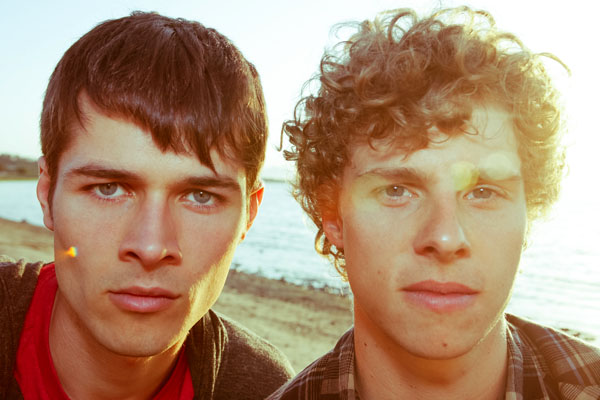
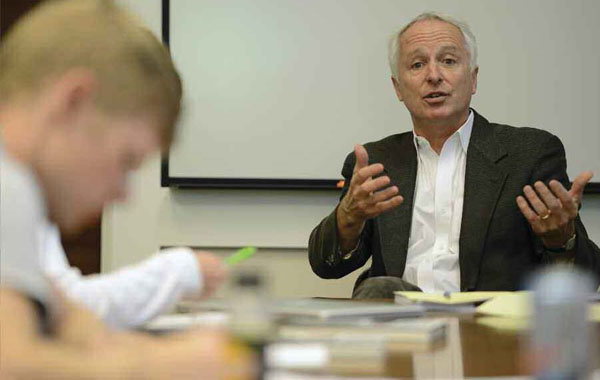
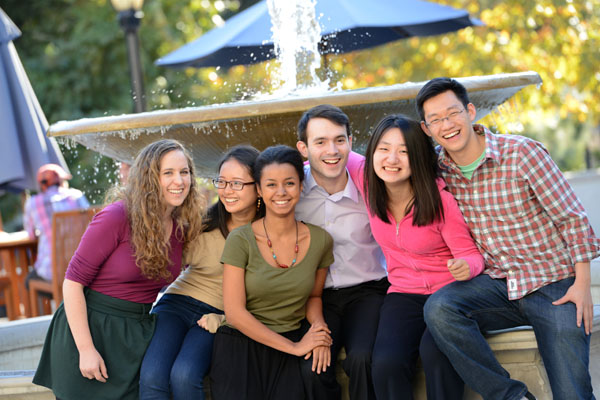
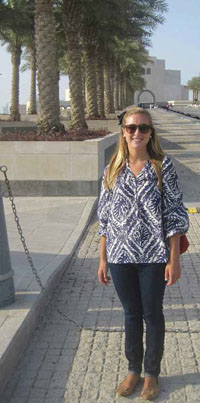 TAKING ON A CHALLENGE Gutowski studied the language for several years in college and even spent some time in the Middle East while she was a student at Pomona, including a semester in Jordan during her junior year. “In Jordan I learned how to conduct my life in Arabic. I could negotiate my rent, get around the city, and attend college classes.”
TAKING ON A CHALLENGE Gutowski studied the language for several years in college and even spent some time in the Middle East while she was a student at Pomona, including a semester in Jordan during her junior year. “In Jordan I learned how to conduct my life in Arabic. I could negotiate my rent, get around the city, and attend college classes.”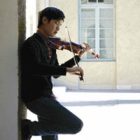
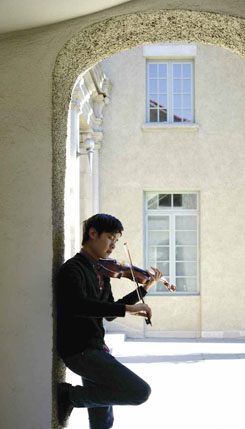 Start piano lessons at 5, violin lessons at 7. Hate practicing but like the stickers you get from parents for doing it. Choose the violin. Enter regional and state orchestra competitions in junior high. Join chamber music quartets in high school and learn you love making music.
Start piano lessons at 5, violin lessons at 7. Hate practicing but like the stickers you get from parents for doing it. Choose the violin. Enter regional and state orchestra competitions in junior high. Join chamber music quartets in high school and learn you love making music.